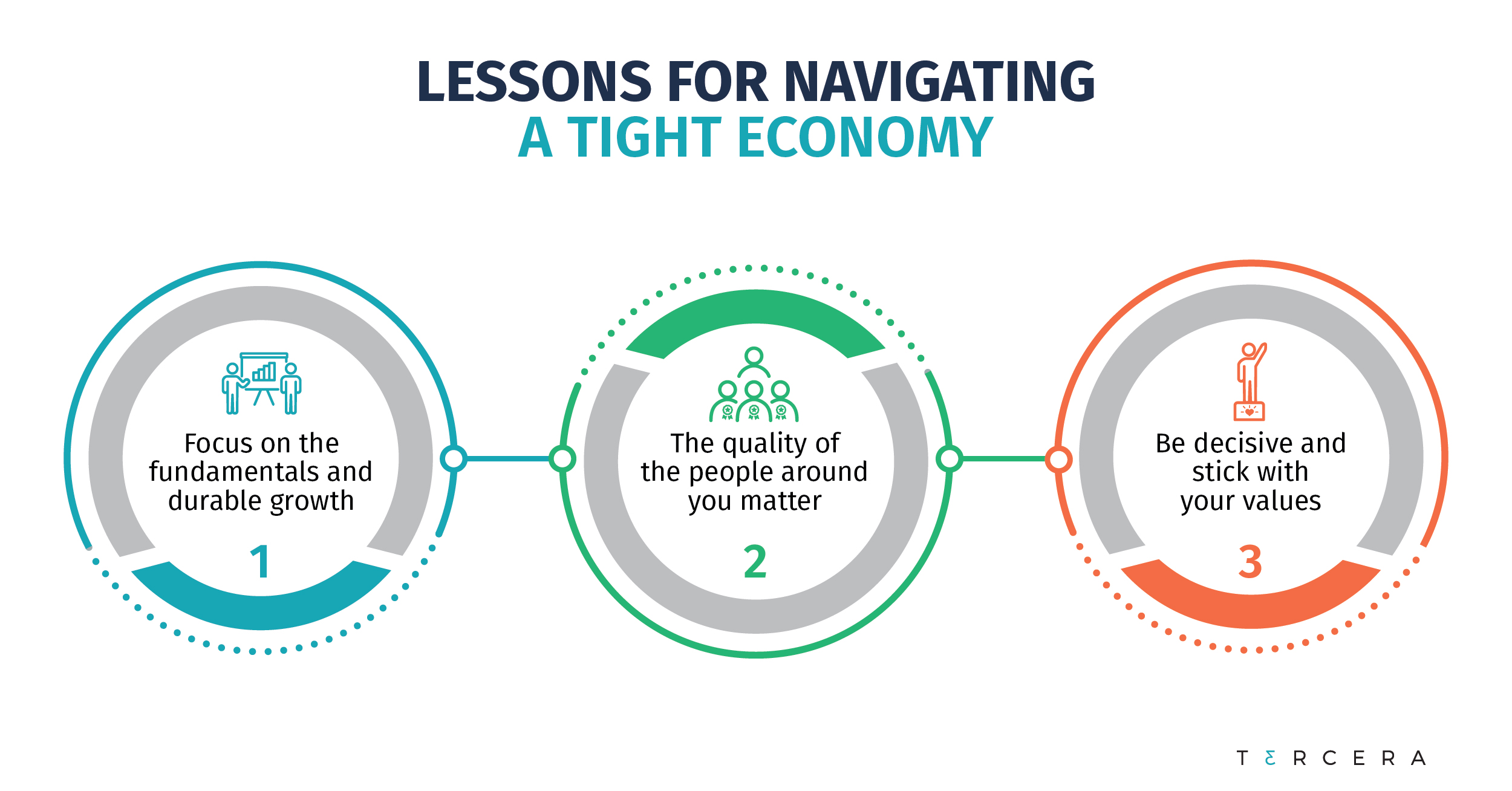I have battled through three bear markets in my 30 year career in technology — some uglier than others. Each one of these markets taught me something different.
My first was in the early 2000s when I led global services for webMethods, an early Internet darling that skyrocketed to a valuation of $10 billion, only to crater when the dot-com bubble burst. This experience led me to write about the risks of overvaluing valuation in September last year, which seems somewhat prescient looking back.
Lesson #1: Focus on the fundamentals because markets are cyclical and they’ll eventually correct.
My second was the 2008-2009 global financial crisis. Appirio had just closed our Series A with Sequoia Capital. I was a first time CEO flush with capital, excited to put it to work. Then I got the call from our new board member, Jim Goetz, summoning me to Sequoia’s office on Sand Hill Road for their infamous RIP Good Times presentation. The guidance I got from Jim, and the ability to lean on others across the Sequoia portfolio, helped us weather the storm. Appirio’s success over the next decade led to its eventual acquisition by Wipro for $500 million.
Lesson #2: When times get tough, the quality and experience of the people you have around the table matters more than ever.
My third was when COVID shut down the global economy. I was advising the leadership team at Traction on Demand, a 1000+ person Salesforce consultancy as Chairman of the Board. Traction’s leadership team made incredibly difficult business decisions incredibly fast — and without abandoning their values. The company came out stronger because of it, and continued its march to become the largest dedicated Salesforce consultancy in North America. Traction was acquired by Salesforce in February 2022 for a multiple that reflected that strength.
Lesson #3: If you’re decisive and you stick to your values, you’ll come out stronger.

Today, we’re advising our portfolio companies at Tercera about how to get through this latest crisis. We don’t claim to have all the answers, but these past experiences can be a guide.
How long will this last?
Buckle up: we’re probably in for a tough 18-24 months. The average duration of the last 14 bear markets was about 20 months (see chart below).

While the stock market isn’t a full proxy of business spend or private market valuations (which tend to lag by 6+ months), it is indicative of trend lines. Tech as a market tends to be more resilient than most, but not all companies will make it through this period. Don’t panic, but don’t underestimate the challenges ahead either.
Start by analyzing your cash flow, and get very clear on what’s coming in and going out of the business. Once you’ve done that, create base, best and worst case scenarios for the next 1-2 years so you can act decisively but not spontaneously.
How will the economic downturn impact IT services specifically?
It’s been a brutal 6 months for publicly traded technology stocks, especially SaaS stocks which saw a huge run up during the pandemic. Many now trade below what they were in early 2020. The collective market cap of the SaaS companies in Bessemer’s Emerging Cloud Index has been halved from an all time high of $2.7 trillion in Nov 2021 to ~$1.3 trillion at the time of this writing.
The trend line is similar but less stark when it comes to publicly-traded IT services firms. Companies like Accenture, Globant, Cognizant and Wipro dropped an average of 37% in the 1H of 2022. Painful for those companies, but not nearly as much as the 52% drop we saw in the EMCLOUD index.
While services spending does tend to track overall IT spend, the slowdown in hiring may actually benefit people-based services firms in the near term.
Over the last year, tech firms have had a very difficult time hiring and retaining skilled talent. That hit services firms particularly hard. Attrition rates were at an all-time high, and wages skyrocketed as companies fought with each other to find and keep talent, putting downward pressure on both growth and margins. Wage inflation and attrition both seem to be leveling off as we see more and more layoffs and hiring freezes, although top talent still commands a premium.
Those layoffs and hiring freezes may benefit service firms in another way. Companies may need to rely more on external consultancies and managed service providers to maintain, protect and evolve their critical systems.
Which services firms are positioned to win?
Those firms that can position themselves as the go-to-partner for critical areas and deliver high ROI are positioned well in this market. At Appirio, during the financial crisis, we grew market share and mindshare because we could deliver faster and take on smaller projects than the traditional Global Systems Integrators (GSIs).
Some services companies are better positioned than others. Those that are in market segments where spending is deemed critical to the business like security, or where spending clearly drives top line revenue growth and market share gains, may see less impact than areas where spend is more discretionary. The industry vertical a digital services firm specializes in also matters. Firms selling to software companies have been hit hard and will have an up-hill battle compared to firms selling to value industries like manufacturing, energy, healthcare and financial services.
What does this mean for M&A?
Over the next 18 months, expect to see a real bifurcation. Great companies with great fundamentals that service a big market will still command a premium when raising capital or being acquired. Good but unexceptional companies will see valuations, growth rates and pricing power shrink. A shakeout, if there is one, isn’t all bad. Great companies will be in a position to acquire good ones and position themselves to take a greater share of the market.
But as interest rates rise and a recession looms, capital has shifted from cheap to expensive. Debt lenders and investors are hunkering down. Companies that have more limited access to capital will want to conserve cash by focusing on smaller, less risky tuck-in M&A deals that help fill in the gaps or diversify offerings. Expect deal terms to shift from all cash deals to stock-based deals with bigger earnouts.
What should services founders do to prepare?
Revisit your plan if you haven’t already. Work with your teams to understand how customer demand and sales cycles are shifting, and the potential impact on pricing, margins and growth rates. Increase profitability but not to the point where it results in your business having negative growth. Customers, employees and investors still reward growth. Just shift your plan to durable growth, not growth at all costs.
Rethink your offerings to what customers need now. When tough times hit, customers tend to shift buying decisions from long-term impact to short-term ROI. Reducing risk, increasing efficiency, and saving money suddenly become more urgent than transformation and innovation. Do your current offerings address these new priorities? Does your packaging or delivery model need to evolve to the way customers now want to buy? Where can you automate to increase your own efficiency and lower costs for customers? Be creative and don’t forget to ask customers for their input.
Evolve your messaging to customers, partners and employees. People’s mindset even six months ago was very different than it is today, and your messaging and positioning may need to evolve accordingly. Stability and security are a lot more important than they used to be. Customers and employees want to work with companies that they can count on to be around for the long term, and partners need assurances you won’t abandon them. Consider how your messaging needs to evolve to a new hierarchy of needs.
Find a peer group. Tough times can be a lonely place for a CEO, and you don’t want to make decisions in a vacuum. Talk with peers who are experiencing the same pressures, and talk to mentors who have navigated these waters before. If you have investors, have them put you in touch with other CEOs and founders in their portfolio. Lean into your Board of Directors and get tight with your leadership team. Remember, you’re all in this together.
How should leaders talk about this with employees?
Communicate early and often. Don’t disappear into your bunker. In uncertainty leaders need to be more visible, not less. Overcommunicate with both customers and employees, so they don’t imagine the worst. Lean now towards a “push” style leadership: when employees need confidence in the company’s long term direction, a more direct approach may be needed. Be sure to balance optimism and realism. You don’t want employees to think the sky is falling, but they also shouldn’t be surprised if layoffs do happen.
Long story short, you can battle through a bear market and come out better as a result. That isn’t easy, but that’s the job ahead. The most important advice I can offer is to stay clear-eyed about what’s happening without letting pessimism and defeatism take over.
This is an opportunity to take a hard look at the fundamentals of your business, make some potentially tough decisions, and (re)position the company for durable growth. It’s the leaders who face reality and adapt with discipline, rather than fear or regret, are those who will win in the end.


